Wapping station opened in December 1879 as part of the East London railway but its story began over 50 years earlier.
in the early 1800s there was a need to connect the north and south docks. There were two unsuccessful attempts to dig a tunnel but these were thwarted by the soft clay and quicksand which caused the tunnel rooves to collapse. The project was declared impractical.
A French engineer, however, believed that he had a solution. Although he he no record of tunnel building he persuaded investors to finance a tunnel from Rotherhithe to Wapping. One of those investors was Arthur Wellesley, the Duke of Wellington. That engineer was called Marc Brunel who had patented a device called the tunnelling shield.
How did this work? Brunel had chanced upon a marine creature called a Shipworm. This bored tunnels through wood but in its wake secreted a coating of limestone particles on the tunnel walls to stop them collapsing.
The shield had similar principles, a round framework accommodating a dozen or so men who would dig into the sand and mud whilst bricklayers reinforced the tunnel walks behind them.
Construction started in 1825 and progress was slow, about a foot per week. There were often leaks and noxious river water would poor through. Other hazards were methane which was inflammable and hydrogen sulphide which was poisonous.
In 1827 the roof was breached and Brunel’s son, Isambard Kingdom Brunel, repaired it using a diving bell lowered from a boat. Afterwards they held a dinner party in the tunnel to celebrate!
It was finally completed in 1843 at a cost of £630,000. Instead of being a thoroughfare between the docks it was ornately decorated and accommodated London’s second shopping arcade!
The tunnel was fashionable to visit, charged an admission fee of one penny to over 2 million people each year.
In 1865 is was purchased by the East London railway and became it’s northern terminus.
It is now the deepest underground station on the Overground network.
In the 1860s a young engineer called James Greathead, inspired by Brunel’s shield, developed his own version and used this to build the second tunnel under the Thames from Tower Hill to Southwark (if you want to know more, come on my Tower Hill walk). Greathead’s shield was subsequently used to build the first tunnelled underground lines including the Waterloo & City and Northern Lines.
The Wapping Tunnel is part of my Docklands North Bank walk.



